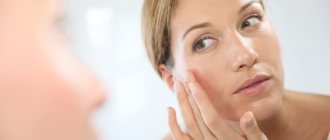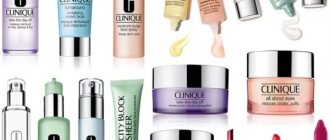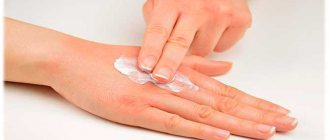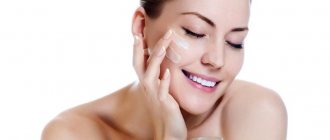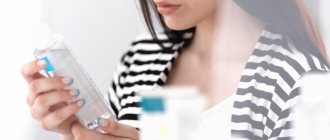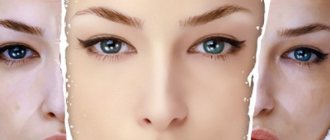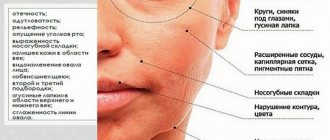Features of care for problem skin
Cleansing. Wash your face with warm water twice a day with foam, gel or lotion (for example, “Clean Line” deep-action cleansing gel). They contain anti-inflammatory components: zinc, chamomile, mint. After washing, wipe your face with a cotton pad soaked in toner or lotion. “Clean Line” facial lotion against blackheads based on zinc, chamomile and aloe vera helps tighten and cleanse pores. To remove makeup, use products without alkaline components that irritate the epidermis. Use micellar water - a safe product for delicate skin care and cleansing.
To even out skin tone and provide deep cleansing of pores, use scrubs that do not contain rough abrasive particles. Remember that even soft scrubs are recommended to be used no more than twice a week.
Hydration. Why does even oily skin need hydration? The fact is that excessive sebum production is a consequence of dehydration. The sebaceous glands begin to actively work to compensate for the lack of moisture. To moisturize your facial skin, use fluid creams with a light texture: they will not clog pores. The composition of such creams includes hydroxy acids (salicylic, malic, lactic or others) to exfoliate dead cells and stimulate renewal, hydrofixatives (hyaluronic acid, algae extracts and others) to moisturize and retain moisture in the skin.
Moisturizing and nourishing masks can be made 2-3 times a week in accordance with the recommendations specified in the instructions. These cosmetics must include ingredients that cleanse the skin. For example, clay and activated charcoal help remove dirt and sebum from pores.
09.03.2021
Problematic skin is often covered with enlarged pores, inflammation, and various types of comedones. But it can look fresh, smooth, well-groomed. It is only important to properly care for such an epidermis.
Competent self-care
A preparation for problematic skin should reduce fat formation, eliminate impurities, and reduce pores. Such a product should be antiseptic and mattifying. These compositions should include:
- sebum regulators (for example, herbal extracts);
- matting components (for example, silicon);
- keratolytics (eg sulfur);
- antibacterial ingredients (possibly retinoids);
- anti-inflammatory substances (chamomile extract is suitable).
Home care is impossible without quality cleansing. The number of daily washes is twice a day. The optimal temperature of heated water is room temperature. Hotter water will only widen the pores and speed up the secretion of oil. You should not use soap, as this will cause the epidermis to dry out and increase greasiness. More effective are gels and foams designed for problematic epidermis. A couple of times every 7 days it is worth carrying out more powerful cleansing, using peelings and masks. Although severely inflamed skin cannot be treated with peelings.
The next stage of self-care is toning. Apply tonic and lotion. These products eliminate residual contaminants, disinfect the skin, and prepare it for the application of nourishing cream.
Mattifying creams must be used. This is the last phase of care. Inflamed skin should be treated with an anti-inflammatory composition. a doctor should select care medications . Otherwise, post-acne manifestations will remain - hyperpigmentation, scars.
You should forget about multi-layer makeup. Owners of problematic epidermis often hide defects with layers of thick makeup. This technique worsens the outflow of sebum and causes inflamed elements. You should select non-comedogenic preparations, the texture of which should be as light as possible.
It is not recommended to fall asleep with a layer of makeup on. Inflammation is guaranteed to occur, the moisture content of the skin will decrease, and symptoms of aging will appear.
Prohibited technique: cauterization, squeezing out acne . At such moments, the skin is torn, the glands are destroyed, and the contamination is only partially removed. This means the inflammation will only intensify. There will probably be a small scar or stain left.
Salon care
These methods include:
- regular comprehensive cleaning (a combination of hardware and manual procedures; before work, the master treats the client’s skin with a gel spray, which allows you to steam the epidermis and enhance the effectiveness of subsequent manipulations; cleaning ends with the use of a pigment-constricting mask; such comprehensive cleansing is carried out monthly);
- photorejuvenation, mesotherapy (often the quality of the skin decreases due to insufficient nutrition; after the listed procedures, the epidermis will be sufficiently moisturized, so the sebaceous glands will begin to work less actively; without excess fat, the skin will quickly recover);
- plasmolifting (allows you to smooth the dermis, even out the color; through tissue injections you receive a large dose of rejuvenating plasma).
Published in Cosmetology Premium Clinic
What not to do
To clear your skin of acne and get rid of problematic shine, stop:
- wash your face with hot water – high temperature expands pores;
- use alkaline soap - it increases the pH (acidity) of the skin;
- regularly use scrubs with coarse abrasive particles - microtraumas provoke increased production of sebum and the appearance of inflammation;
- use alcohol-based products - it dries the skin, so due to dehydration, more liquid fat is produced;
- ignore sunscreen when in the sun - ultraviolet radiation dries the skin, but at the same time weakens its protective properties;
- use cosmetics with silicones and parabens: try Aqua-cream Instant matte from “Clean Line” - it contains natural ingredients that will not only protect the skin, but also provide it with nutrition;
- use scrubs in the acute phase of acne - they can intensify the inflammatory process;
- squeezing pimples is fraught with the appearance of marks (post-acne), which are difficult to combat.
A dermatologist can tell you more about how to care for problem skin and what causes acne and pimples. He will select individual treatment after diagnosis.
You can also use the Clean Line beauty bot, where our specialists will help you choose the right product and give advice on skin care.
Application of Azelik® gel in the treatment of acne
It is not enough to use a cleanser or wipe your face with toner. It is important to use medications selected by a specialist. Thus, for mild to moderate acne, azelaic acid preparations are indicated9. One of them is Azelik® gel. Its use helps normalize keratinization and reduces the amount of free fatty acids on the skin5.
Azelaic acid has antimicrobial activity against Staphylococcus epidermidis and propionibacteria5. The anti-inflammatory effect of 15% azelaic acid gel is explained by a decrease in the metabolism of neutrophils and the free radical forms of oxygen they synthesize5.
First stage of cleansing: makeup removal
One of the main stages of cleansing problematic oily skin is removing makeup. Micellar water is perfect for these purposes. This light and comfortable liquid will not leave a film or an unpleasant feeling of tightness on your face, but will allow you to remove all makeup.
Hydrophilic oil is also suitable for removing stubborn makeup. This product will help quickly and easily dissolve stubborn makeup and remove sebum. It is also important that hydrophilic oil itself is very easily washed off and does not leave a film on the face.
Unwanted Shine: Why Problems Occur
First, let's talk about skin that is excessively oily: pimples and blackheads constantly appear on it, it has a rough pattern, and is often rough to the touch. Why is this happening? The main reason is the active work of the sebaceous glands.
What caused it?
- Constitutional characteristics (for example, a tendency to diseases of the gastrointestinal tract).
- Hormonal imbalance (most often occurs during puberty and pregnancy).
- Nervous disorders that cause deterioration of the skin.
- Endocrine diseases (directly related to increased production of sex hormones or their deficiency).
- Improper diet (with a predominance of fatty and spicy foods, lack of vitamins).
- Improper care (use of inappropriate cosmetics or complete lack of hygiene and cosmetic procedures).
Lumpy, oily skin that is prone to acne occurs in both women and men. This problem makes itself felt especially often in adolescence. The exacerbation occurs in the summer.
Carrying out cleaning
Once everything you need is ready, you can begin cleaning. To avoid damaging the skin and getting the opposite effect, it is recommended to follow the rules.
The first thing you need to do is cleanse your face of dirt and makeup. This can be done using any usual cleanser.
The second step will be the removal of keratinized particles. Any scrub will be suitable for this, both store-bought and homemade. Be sure to lightly moisten your face with warm water before applying the product. Afterwards, massage it with gentle circular movements and leave the scrub for a few minutes.
The third stage of cleaning includes steaming. You should tilt your head over a bowl of hot water or herbal decoction, cover with a towel and steam your face for about 15 minutes. You can add a few drops of antiseptic essential oil to boiling water.
After the skin has steamed sufficiently, it is time for deep cleaning. Using a cosmetic spatula, gently squeeze out blackheads and pimples. After this, you need to wash your face with a decoction of herbs.
Complete the peeling by applying a mask. It is advisable to use natural ingredients - sour cream, honey, vegetables or fruits. After 15-20 minutes, the mask can be washed off and cream applied.
Are there any contraindications for facial cleansing?
It is not recommended to cleanse the skin of the face during acute colds and inflammatory diseases, immediately after operations and on menstruation days. For eczema, psoriasis, dermatitis, and allergic reactions. Use with caution in case of allergies, hormonal dependence, psoriasis and eczema. And during heat and severe frosts, only gentle types of facial cleansing are carried out.
On the contrary, ultrasonic facial cleansing may be indicated for those who have medical contraindications to mesotherapy.
Age labels for cosmetics
What are the criteria for choosing skin care products at different ages and why can’t you use a cream labeled anti-age if you are over 20 years old?
Taking into account the age-related characteristics of the skin, as the body matures, skin care will change:
- At 20+ years of age, the body’s natural aging process begins, and although the first external signs of skin maturity will not be noticeable soon, now is the time to take care of aging prevention. Skin at this age needs antioxidant support and intense hydration. From the age of 25, you should include eye moisturizers in your beauty routine. Young skin makes the most of its own resources and renews itself well, so moisturizing and regular cleansing will be enough to maintain its tone.
- At the age of 30+, the body already noticeably decreases the synthesis of hyaluronic acid, collagen and other elements necessary to maintain the density, firmness and elasticity of the skin. By the age of 35, age-related changes become noticeable: facial wrinkles, dehydration creases, skin loses tone. It is recommended to enhance antioxidant support, add UV protection and include anti-aging formulas based on hyaluronic acid and collagen in your beauty routine.
- At 40+ years of age, the time comes to fully combat age-related changes. By the age of 45, many people experience such noticeable manifestations of skin maturity as pigmentation, deformation of the oval of the face, deep creases and a network of fine wrinkles in the eye and lip area, and decreased skin turgor. At this age, the cosmetic bag is replenished with products containing retinol, peptides, and rhamnose.
- At 50+ years of age, a period of age-related hormonal changes in the body begins. Almost all elements that maintain youth and skin tone stop natural synthesis and must be replenished with the help of appropriate compensatory care. The contours of the face begin to change, gravitational ptosis appears, the skin becomes thinner, loses density, becomes dry and sensitive. Compensatory care includes powerful anti-aging formulas that replenish moisture and collagen deficiency in skin cells.
Is it effective to cleanse your face if you have acne*?
Vacuum, ultrasonic, atraumatic, mechanical facial cleansing for acne is quite widely used in domestic and foreign clinical practice. Despite the lack of full-fledged research on the effectiveness of these techniques in the treatment of acne*, doctors' observations show that in some cases they can have a positive effect. [152]
But it is important to correctly optimize the use of any of the available technologies. To achieve a sustainable result, the procedure must be carried out in compliance with sterility and safety measures, as well as at a certain frequency, which depends on the characteristics of the patient’s skin. [152]
Cosmetics for oily skin
Cosmetics for oily skin care should contain:
- herbal ingredients (chamomile, witch hazel, lemon balm, sage, rosemary, quince bark, ylang-ylang),
- alpha hydroxy acids (fruit acids),
- urea,
- silicon,
- ammonium compounds,
- vitamins A and E,
- bisabolol,
- azulene and aluminum salts.
The use of natural mineral cosmetics will solve the problem of “blackheads”. It has antibacterial properties and protects the skin from UV radiation. An alternative to foundation can be concealer, which, when applied topically, masks skin imperfections. Zinc oxide in concealer will be an advantage.
Life without water: dryness and tightness
It’s not just the excessive work of the sebaceous glands that worries many women. A lot of anxiety and discomfort arises due to dehydration of the surface layer of the epidermis. Loss of moisture leads to peeling, redness, and irritation. This problem is the opposite of the one discussed above, but no less relevant.
If oily skin shines, then dry skin looks dull, dead scales appear on it, it suffers from exposure to strong wind or sun, and wrinkles form on it earlier.
The causes of dehydration can be different - both external and internal:
- Genetic predisposition (people with blond hair and pale skin most often experience peeling and irritation).
- Disturbance in sleep patterns (if you don’t get enough rest, this affects the condition of the epidermis).
- Poor nutrition (lack of protein, vitamins B, A, C and E, polyunsaturated fatty acids, a lot of sweets, strong tea and coffee).
- Diseases of the liver and kidneys (in a person suffering from impaired functioning of the kidneys and liver, the elasticity of tissues is lost, the barrier and moisture-saving properties of the epidermis deteriorate).
Lack of proper care can also cause the condition to worsen.
Why is professional facial cleansing better than home cleansing?
Self-indulgence in such an important issue as facial skin health can be fraught with many troubles. You can introduce an infection and increase existing inflammation. Inept actions can even lead to acne becoming chronic. It is almost impossible to provide the necessary sterility at home. Only a professionally performed facial cleansing procedure provides excellent results - clean, smooth and even skin without blackheads and acne.
In addition, prices for facial cleansing in the Centers are OK! completely democratic and accessible to many. It is not surprising that today facial cleansing in our clinic is one of the most popular cosmetic procedures.
Clinical researches
The La-Cri Atoderm line was developed jointly with Professor Denis Vladimirovich Zaslavsky, chief specialist in dermatovenereology and cosmetology of the Ministry of Health of the Russian Federation in the Northwestern Federal District of the Russian Federation.
The products are characterized by clinically proven effectiveness.
Sources:
- Baumann Leslie, Cosmetic Dermatology. Principles and practice, MEDpress-inform, 2016.
- Ratner Desiri, Avram M.R., Avram M.M., Procedures in Dermatology. Clinical cosmetology, GEOTAR-Media, 2022.
- Sukolin Gennady Ivanovich, Clinical dermatology. A short guide to the diagnosis and treatment of dermatoses, Notabene, 2017.
